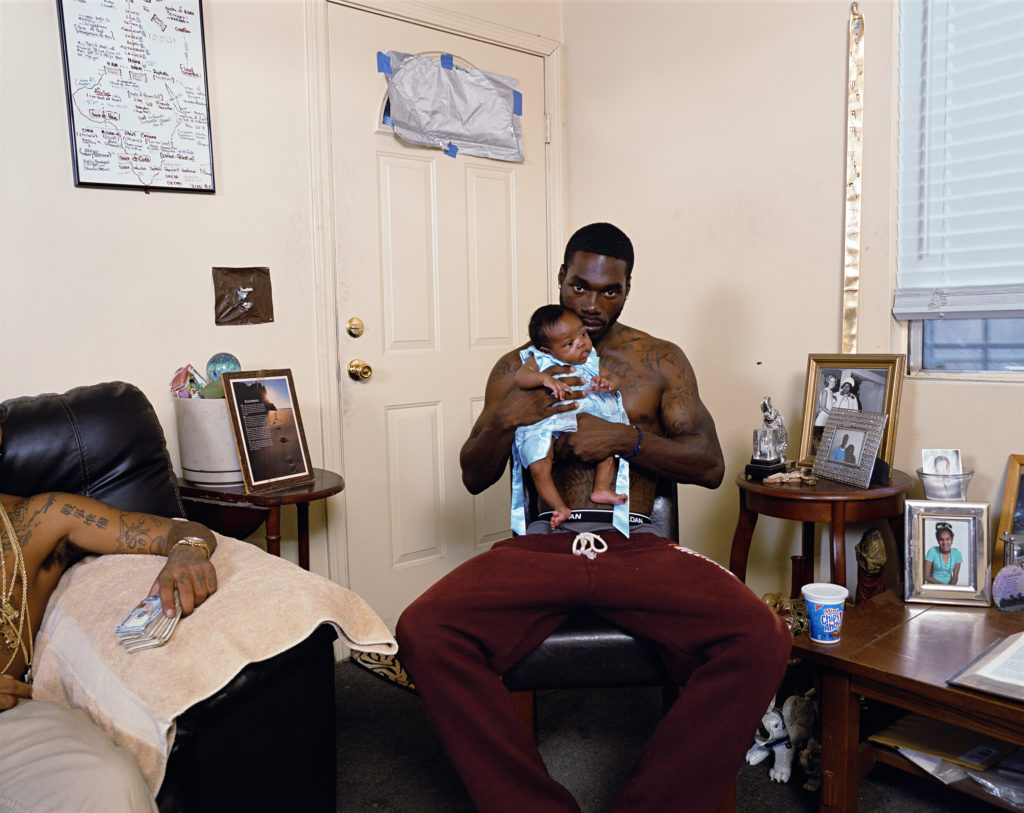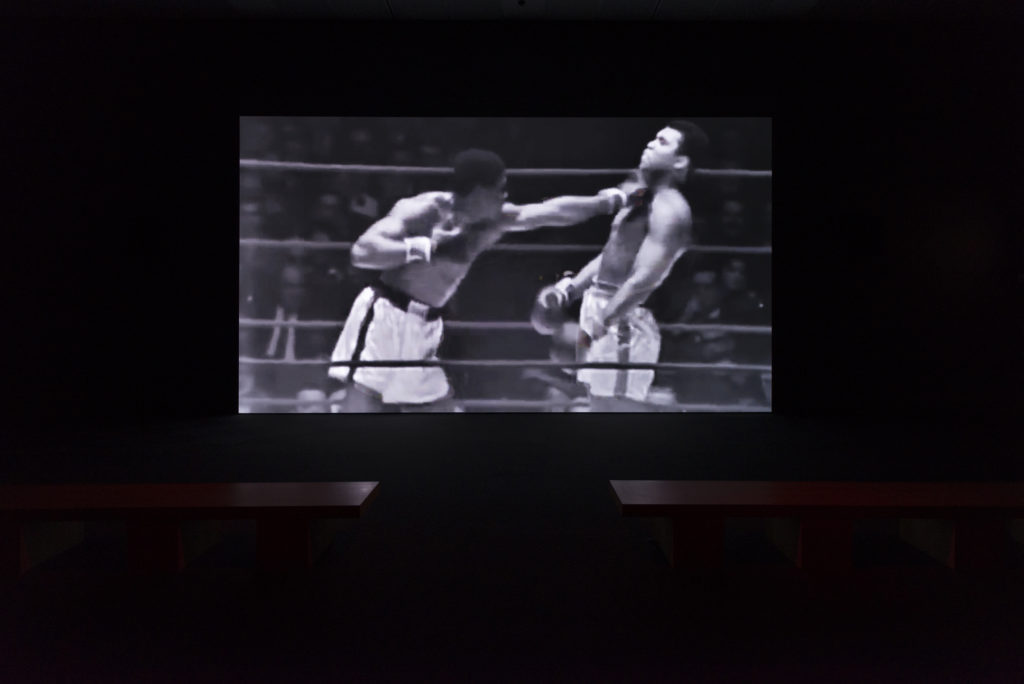Krista Thompson a Sidelong Glance the Practice of African Diaspora Art History in the United States

It is challenging to depict an exhibition where the central artwork is so overwhelmingly exhilarating, nowadays, and difficult. Yet, such is the predicament for viewers of Prisoner of Dearest at the Museum of Gimmicky Art (MCA) Chicago. Curated by Naomi Beckwith, the show sources its title from Glenn Ligon's piece of the same name. The museum's recent acquisition of Arthur Jafa'southward acclaimed video slice, Honey Is The Bulletin, The Bulletin Is Expiry (2016), acts as the impetus of the show. Though an enormous installation in scale and chapters, Jafa's work is padded by an evolving constellation of artworks that explore the immensities of life and death, love and hate, pleasure and pain—themes pulled from Bruce Nauman'south well-known neon piece, Life, Expiry, Love, Hate, Pleasure, Pain (1983), also included within the exhibition. The iii chapters of the exhibition motion between these dualities, mobilizing a rotating cast of approved artists, such every bit Carrie Mae Weems, Catherine Opie, and Doris Salcedo, amidst others.
Beckwith's curatorial approach spatializes what Krista Thompson has termed the 'sidelong glance'— "sidelong glances at Western art and cultures of vision…[are] a knowing way of looking that is very aware of, and in many regards averting, being seen in overdetermined ways on account of 'color.'" one As such, i of the permanent fixtures of the exhibition is the opening relationship between Nauman's loud, central, and commercially-cognizant neon work, and Glenn Ligon's shade-throwing, though much quieter painting installed to its right, entitled Untitled (Study #ane for Prisoner of Love) (1992). Through the proximity of these two works, the universalism embedded in Nauman'south understanding of the man condition is contested by Ligon's racialized use of appropriated text "WE ARE THE INK THAT GIVES THE WHITE PAGE A Pregnant," which identifies a reading of blackness subconscious in evidently sight. This opening centrality to the exhibition provokes a productive tension in subjectivity—questioning who is looking, who is feeling, and how these deportment are linked.
For viewers, Jafa's central artwork exists just beyond this first dialectic encounter. Like to his other filmic works, Love Is The Message… amasses a series of institute, disparate video clips, that convey an ontology of blackness for Jafa, many representing images of black people across fourth dimension. The single-channel, vii:30 infinitesimal video samples materials ranging from university pep rallies, civil rights movement protests, Gospel music concerts, and Jafa'southward ain footage of theorists, such equally Hortense Spillers. Rather than distill blackness life into a narrow search for survival, the sampled images' final collaged form illustrates how "black subjects navigate the afterlife of slavery in moments that span the emotional register—from laughter to refusal to quiet contemplation." two In Dearest Is The Message…, Jafa focuses on images and sound to concentrate a combined affective 'book' that is so dumbo it brings nightmare and ecstasy into shut proximity—retaining a sublime incompressibility that somehow becomes atypical.
The rhythm of Jafa's syncopation of images inside the picture show is guided by the soundtrack of Kanye West's "Ultralight Beam"—a song that has been termed a gospel-infused "street parable." 3 Jafa has remarked on multiple occasions that in his piece of work he aspires "to make a blackness cinema with 'the power, beauty, and alienation of blackness music.'" 4 Through Jafa's manipulations of speed, tactful shearing, and incorporation of sound, the varied visual source material congeals into an evererupting pulse. The work becomes fragmented, incomplete, and narratively unstable—certainly embodying his aspirations for a black movie theatre.

restricted gift of Sally. Courtesy of the artist and Rhona Hoffman Gallery.
Part of the work's ability to stir extreme bear upon—joy, horror, rage—is designed past its rhythmic hypnotism, which leaves viewers unable to resist complicity in Jafa'southward peppered images of violence. It is this attribute that forms some of the video's more haunting sequences. 1 case is a legendary vogue battle betwixt the late Kassandra Ebony and Leiomy Maldonado (known equally the "Wonder Woman of Vogue") that curtly transitions via a death driblet fake out into a woman being smacked beyond the room and knocked out. Maldonado'south deadening motion, gravity-defying stunt recalls The Matrix (1999), inspiring exhilaration and joy in viewers—however that joy chop-chop evaporates every bit the infamous death drop seamlessly folds into actual violence. Images continue to spring in content and affective measure out—from the skilled scoring of an NFL touchdown, to Okwui Okpokwasili'southward strained solo choreography—the melding of multiple cultural forms into a single complex schema. This unending compression snowballs into the single video work that is Dear Is The Message…, focusing Jafa'due south concept of black while sporadically likening its immensity to that of the glaring sun.
Art historian Huey Copeland connects Jafa'southward work to black feminist artists before him, such equally Renée Green and Lorna Simpson—artists who transgressively imagine how black bodies can be imaged in new configurations. Copeland posits that "Jafa'southward works tin can be understood equally forms of anti-portraiture that qualify the stilled representation of black figures in order to illuminate the dialectical relation between the cocky and the social." 5 This dialectic is woven as a constant spiral throughout Love Is The Message…, attuning viewers to one's disability to command how the self is constructed past perceptions of race, ethnicity, gender, sexuality, etc. at the societal level. Inside this context, blackness is shaped by the complexity of these signifiers' interlocution.
Whereas the act of condign visible ofttimes provides the relief of representation, it subsequently binds a subject in expectation, calculability, and limitation. Jafa's film adheres to this conception, but pushes farther, then that the images envisioning possibilities of blackness are inexhaustible. The cropped condition of these video clips reminds viewers that much has been left out, also pointing to the conceptual and material limits of visibility. Though Jafa'south work considers blackness' confrontation with being seen, its bitty condition continuously evades seizure.
There is, however, an inevitable end to the video, signaling a death to the image that simultaneously represents and binds. The ending aptly depicts a collapsing James Brownish during a 1964 operation of "Please, Please, Please." 6 The original version shows Dark-brown existence picked support to his feet and cloaked in blanket, presumably to care for him, merely more so to enforce his responsibleness to perform. Jafa'southward appropriation cuts earlier, where Brown is still on his knees pulling away from his impending and unwilling resurrection. The screen and music abruptly drown out as Dark-brown exhaustingly screams.

Post-obit Jafa'southward complex slice, viewers run into two surprisingly disappointing works by David Hammons and Lynda Benglis, which lazily appropriate Buddhist iconography and the Hindi language respectively. These pieces unfortunately undermine the complex embodiment of identity in Honey Is The Message by perpetuating the shortsighted notion that Eastern spiritual practices can 'heal' the wounds the W has inflicted, illustrating a reductive Eastern essentialism in tow. The residual of the "life and death" iteration of the exhibition expands upon Jafa's emotionally raucous picture into quieter territory. Melvin Edwards's Off and Gone (1992) welds together volatile and aged metal fragments similar chains and hooks to constrict a much more pristine water faucet. Here, the heaviness of history chokes life's flow. Catherine Opie's melancholic photograph of a demure, veiled, and empty armchair that floats before a blue drenched backdrop is utterly arresting when viewers note its title, In Memory/Leigh Bowery (2000). Anyone enlightened of Bowery's exuberance for bright colour, wild forms, and outlandish fashions volition instantly become cognizant of the deep reaching feeling of loss registering on the body. The residual impression left on the empty chair longingly conjures the beautifully complex, warm fullness of Bowery's persona, yet is unable materialize an image for united states to grasp. Though much of this exhibition confronts the limits that images impose on us as human subjects, Opie's work demonstrates that sometimes all we want is simply one more than photograph to hold onto.
As the exhibition cycles through its remaining two chapters—entitled "Love and Detest" and "Pleasure and Pain"—younger artists, such as Paul Mpagi Sepuya, Deana Lawson, and Michael Armitage bring farther dimension to black figuration. The show's central grounding of blackness causes a ripple through the imagistic strictures that configure identity'south advent within the cultural field. However, one wonders if any epitome— singular, moving, abstruse, or collaged—can friction match Jafa'due south cogitating use of the dominicus to describe the immense, astronomical feelings that one life can contain.
Prisoner of Love at the Museum of Contemporary Art, Chicago ran through October 27, 2019.
- Thompson, Krista A. "A Sidelong Glance: The Exercise of African Diaspora Fine art History in the The states." Art Journal 70 (2011): 11.
- Copeland, Huey. "b.O.due south. 1.3 / Love Is the Bulletin, The Message Is Death." ASAP/J. September fifteen, 2018. Accessed March 5, 2019.
- Kelly Price quoted in The FADER. Tanzer, Myles. "The True Story Of Kanye West's "Ultralight Beam," Equally Told By Fonzworth Bentley." The FADER. Apr 04, 2018. Accessed March 05, 2019.
- Campt, Tina and Arthur Jafa. "Honey Is the Message, The Plan Is Death," eastward-flux Journal 81. April 2017. Accessed March five, 2019.
- Ibid.
- James Brown. "James Chocolate-brown Performs "Please Please Please" at the TAMI Testify (Live)." Filmed October 1964. YouTube video, 6:16 minutes. Posted March xvi, 2013. Accessed March 5, 2019.
hollidaythoreeduck1994.blogspot.com
Source: https://theseenjournal.org/an-in-exhaustible-image/
0 Response to "Krista Thompson a Sidelong Glance the Practice of African Diaspora Art History in the United States"
Post a Comment